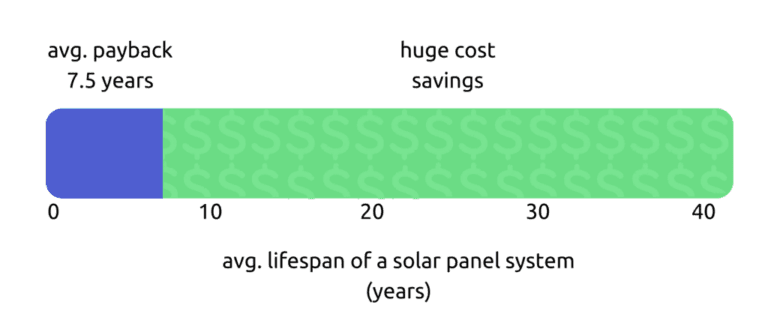How Long Do Solar Panels Take to Pay for Themselves?
Many Americans are becoming increasingly aware of the financial benefits of installing solar panels. Solar energy is a way for homeowners and businesses to invest in massive energy savings that will quickly add up and save them money in the long run.
However, the most common question is “How long does it take for solar panels to pay for themselves?”
The payback period of your solar panel installation is affected by a variety of factors. Some are simple to calculate, while others are more difficult. Fortunately, we can assist you in breaking down these factors and providing a more accurate picture of your solar panel payback period.

What is a Solar Payback Period?
The solar panel payback period is a calculation that determines how long it will take your solar installation to pay for itself.
In other words, the payback period for solar panels is the amount of time it takes for your solar system to “break even” and recoup the initial cost of your investment. This time period is also known as the solar break-even point.

How is the Solar Panel Payback Period Calculated?
To calculate your payback period, you must first determine the total costs and benefits of the installation. Several factors influence the total costs and benefits of going solar.
If you’re looking for a quick average payback period, most businesses can expect it to take between 5 and 10 years. Keep in mind that numerous variables can significantly affect this.
Cost of Your Solar Energy System
The most expensive expense is the gross cost of your solar panel system. This is the total cost of your solar panel system before any financial incentives are applied. This amount is determined by the size of your solar installation, the equipment you use, and the amount of labor involved.
Value of Financial Incentives
Across the country, there are numerous solar incentives available. These solar incentives include rebates, tax credits, and more from the federal, state, and local governments. These incentives can significantly reduce the cost of installing solar panels while also shortening the payback period.
Average Monthly Electricity Usage
An important first step in determining how much energy you want to offset is to calculate your average monthly electricity usage. The greater your monthly electricity consumption, the greater the potential savings from solar. In turn, the shorter your solar payback period!
Estimated Electricity Generation
It is important to design a solar panel system that meets your energy usage needs. Our solar design process will consider factors such as the number of panels that can fit on your property, seasonal weather patterns, future energy demand increases, among others. We will then design a solar panel system that meets your desired energy offset.
Calculating the Payback Period for Your Solar Energy System
Now that you understand the factors that influence the total costs and benefits of the installation, you can calculate your solar panel payback period.
To do so, follow these steps:
1. Calculate the total costs
Subtract the total value of all incentives and rebates from the total cost of your solar energy system.
2. Calculate your annual benefits
Add up all of the potential annual financial benefits, such as avoided electricity costs.
3. Subtract your total costs from your annual financial benefits.
This is the number of years it will take for your solar panels to pay for themselves. After this period, you will have passed the “break even” point. From here, you will be able to reap the full financial benefits of your solar panel system.
If you’re just getting started with solar and want a ballpark estimate for an installation, use our Solar Calculator. It provides upfront costs and long-term savings estimates. For those looking for a quote, call (501) 683-8835 to speak with one of our knowledgeable solar energy specialists!
